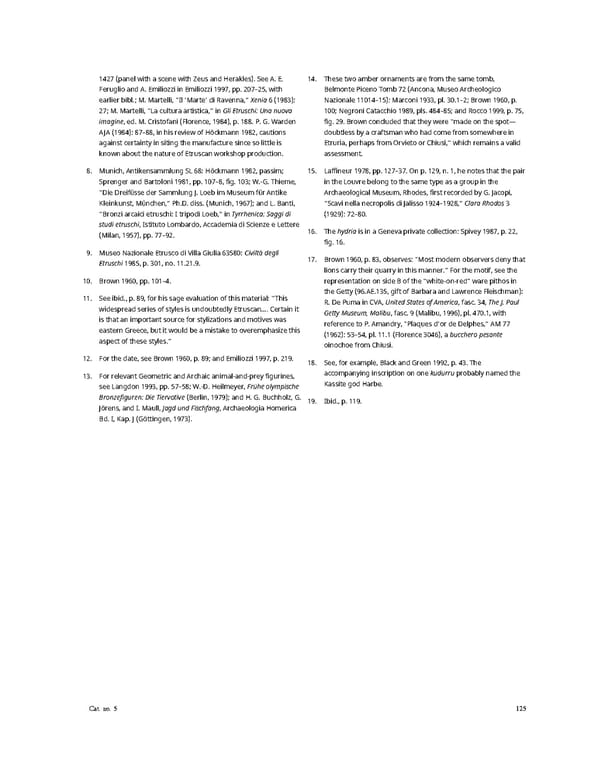1427 (panel with a scene with Zeus and Herakles). See A. E. 14. These two amber ornaments are from the same tomb, Feruglio and A. Emiliozzi in Emiliozzi 1997, pp. 207–25, with Belmonte Piceno Tomb 72 (Ancona, Museo Archeologico earlier bibl.; M. Martelli, “Il ‘Marte’ di Ravenna,” Xenia 6 (1983): Nazionale 11014–15): Marconi 1933, pl. 30.1–2; Brown 1960, p. 27; M. Martelli, “La cultura artistica,” in Gli Etruschi: Una nuova 100; Negroni Catacchio 1989, pls. 484–85; and Rocco 1999, p. 75, imagine, ed. M. Cristofani (Florence, 1984), p. 188. P. G. Warden fig. 29. Brown concluded that they were “made on the spot— AJA(1984): 87–88, in his review of Höckmann 1982, cautions doubtless by a craftsman who had come from somewhere in against certainty in siting the manufacture since so little is Etruria, perhaps from Orvieto or Chiusi,” which remains a valid known about the nature of Etruscan workshop production. assessment. 8. Munich, Antikensammlung SL 68: Höckmann 1982, passim; 15. Laffineur 1978, pp. 127–37. On p. 129, n. 1, he notes that the pair Sprenger and Bartoloni 1981, pp. 107–8, fig. 103; W.-G. Thieme, in the Louvre belong to the same type as a group in the “Die Dreifüsse der Sammlung J. Loeb im Museum für Antike Archaeological Museum, Rhodes, first recorded by G. Jacopi, Kleinkunst, München,” Ph.D. diss. (Munich, 1967); and L. Banti, “Scavi nella necropolis di Jalisso 1924–1928,” Clara Rhodos 3 “Bronzi arcaici etruschi: I tripodi Loeb,” in Tyrrhenica: Saggi di (1929): 72–80. studi etruschi, Istituto Lombardo, Accademia di Scienze e Lettere 16. Thehydriais in a Geneva private collection: Spivey 1987, p. 22, (Milan, 1957), pp. 77–92. fig. 16. 9. Museo Nazionale Etrusco di Villa Giulia 63580: Civiltà degli 17. Brown 1960, p. 83, observes: “Most modern observers deny that Etruschi 1985, p. 301, no. 11.21.9. lions carry their quarry in this manner.” For the motif, see the 10. Brown 1960, pp. 101–4. representation on side B of the “white-on-red” ware pithos in 11. See ibid., p. 89, for his sage evaluation of this material: “This the Getty (96.AE.135, gift of Barbara and Lawrence Fleischman): widespread series of styles is undoubtedly Etruscan.… Certain it R. De Puma in CVA, United States of America, fasc. 34, The J. Paul is that an important source for stylizations and motives was Getty Museum, Malibu, fasc. 9 (Malibu, 1996), pl. 470.1, with eastern Greece, but it would be a mistake to overemphasize this reference to P. Amandry, “Plaques d’or de Delphes,” AM 77 aspect of these styles.” (1962): 53–54, pl. 11.1 (Florence 3046), a bucchero pesante oinochoe from Chiusi. 12. For the date, see Brown 1960, p. 89; and Emiliozzi 1997, p. 219. 18. See, for example, Black and Green 1992, p. 43. The 13. For relevant Geometric and Archaic animal-and-prey figurines, accompanying inscription on one kudurru probably named the seeLangdon 1993, pp. 57–58; W.-D. Heilmeyer, Frühe olympische Kassite god Harbe. Bronzefiguren: Die Tiervotive (Berlin, 1979); and H. G. Buchholz, G. 19. Ibid., p. 119. Jörens, and I. Maull, Jagd und Fischfang, Archaeologia Homerica Bd. I, Kap. J (Göttingen, 1973). Cat. no. 5 125
 Ancient Carved Ambers in the J. Paul Getty Museum Page 134 Page 136
Ancient Carved Ambers in the J. Paul Getty Museum Page 134 Page 136